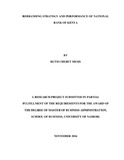| dc.description.abstract | Organizations throughout the world have had to use one strategy or another, in order to improve their performance. This is as a result of the emerging trends that have intensified the level of competition among different firms, causing them to strategize in order to stay ahead of competition. The banking industry globally has witnessed intense competition and the Kenyan banking industry has not been spared. The sector is undergoing a period of major upheaval and restoring customer confidence has emerged as priority as customers are increasingly demanding higher quality of service from their banks. The purpose of this study was to examine rebranding strategies in relation to performance of National Bank of Kenya. The objectives of the study were to determine the relationship between the rebranding strategy and performance, and the challenges of rebranding. The research was designed as a case study. Primary data was collected from managers through in-depth interviews using an interview guide, while secondary data was obtained from the National Bank library and other literature. Data collected from the study was analyzed qualitatively using content analysis and presented herein. The study revealed that NBK has recently undergone a transformation drive where it has rebranded and not only created a new vibrant look, but has also radically changed the way they carry out their operations. This study established that several departments have been actively involved in the process which touched on the bank‟s corporate colors, advertising, corporate social responsibility, staff development, customer service, their slogan, mission and vision. As reiterated by the interviewees, rebranding has helped the bank in implementing its overall strategic plan by enhancing the image of the organization and bringing out the organization‟s competitive positions in the industry. The challenges faced were many and included resistance by employees who were demotivated and unskilled, poor communication and high costs. These challenges were well addressed and the study confirms that indeed rebranding can affect performance of an organization. The study recommends that the industry regulator needs to understand the relation between rebranding and performance and consider it as a policy option. The study also demonstrates the application of the Resource based theory and the Dynamic Capabilities theory and that NBK and indeed other players in the industry are encouraged to keep improving their resources in order to stay ahead of competition. Availability of interviewees was a major limitation to this study, however, those interviewed were most helpful. From this study, other areas that can be researched on include rebranding in other industries and employee involvement in rebranding. This research conclusively confirms that despite the challenges involved, rebranding does have a profound effect on performance. | en_US |



